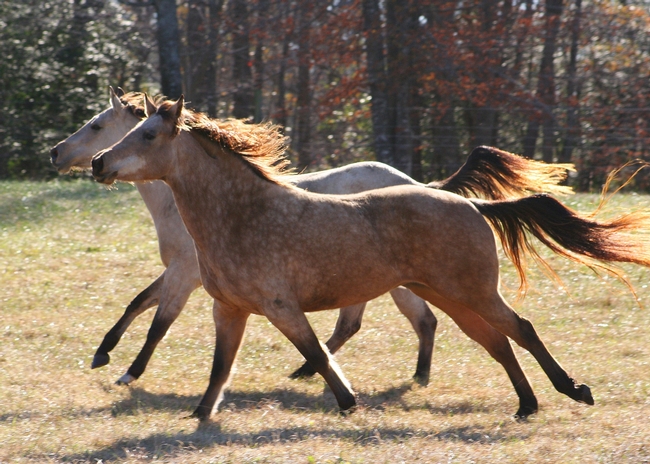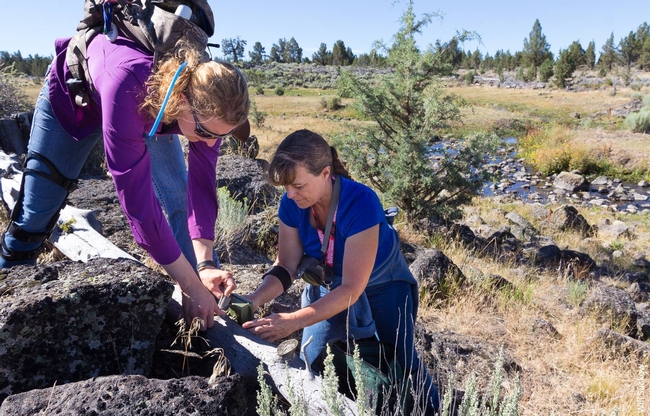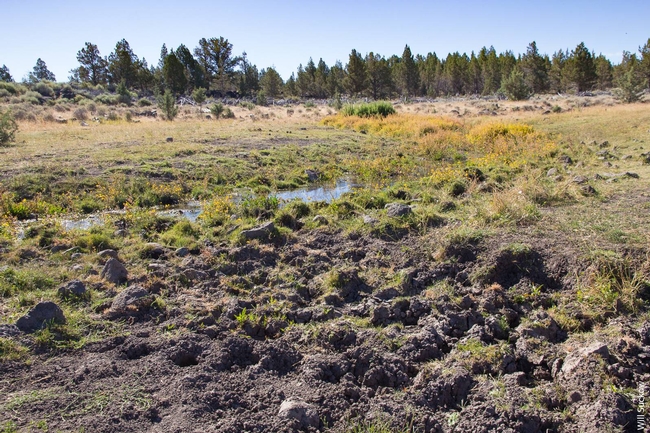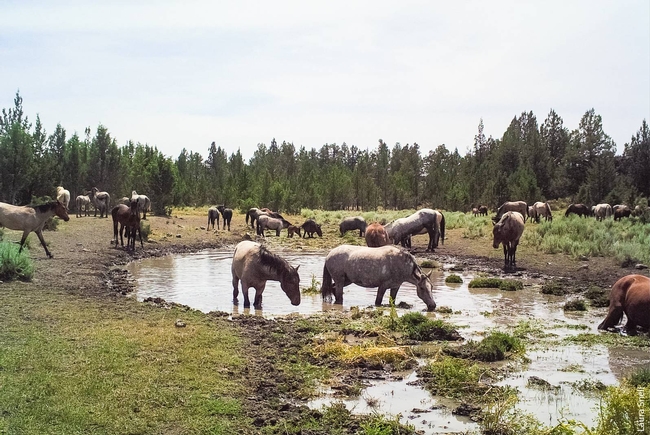- Author: Jeannette E. Warnert
Most Americans envision healthy mustangs galloping free on the range when they think about the country's wild horse population. But UC Cooperative Extension rangeland advisor Laura Snell sees another image.
In conducting research on the over-populated wild horse territory at Devil's Garden Plateau in Modoc County, she witnesses a group of horses visiting a dwindling and damaged pond.
“Maybe there is enough for the lead stallion and the lead mare to drink. The rest stand there and look longingly at the diminished water source,” Snell said. “They do not seem content.”
The research Snell has underway at Devil's Garden was chronicled in the current issue of California Agriculture journal by executive editor Jim Downing. The federal government has determined the ideal horse population on the 230,000 acres of wild horse territory is no more than 402, however, more than 2,000 wild horses are running on the land.
Snell began working in the remote northeast corner of California in 2015.
“I had Modoc County ranchers coming up to me on my second day of work asking me how to solve the wild horse issue,” she said.
She realized that agencies and authorities responsible for policies that determine the horses' fate, and advocates who lobby strongly that the horses should be cared for humanely, don't see the poor conditions suffered by the horses and the environmental degradation of the land.
“The area is a quarter million acres in size. There are no main roads, so you have to take ATVs to see the horses,” Snell said. “We realized we needed to provide visuals to show people the horses and what the landscape looks like due to unmanaged grazing by the wild horses.”
Snell places wildlife cameras for two-week periods near 24 remote water sources in wild horse territory in Modoc and Lassen counties. At each site, the camera takes a burst of three pictures automatically every 15 minutes; motion detectors on the cameras also trigger a shot whenever an animal enters the field of view.
Preliminary data from 2015 show some striking findings. At one spring site, for instance, more than 71 percent of all animals detected over the sampling period were horses. Cattle accounted for 19 percent and the rest were pronghorn antelope, deer and hawks. The study will continue through 2017.
Wild horses are running in the Devil's Garden territory, and outside the territory, on private and tribal land. Fences don't hold the horses in, Snell said. Federal wild horse management areas are intended for multiple uses, including livestock grazing, hunting, and wildlife habitat. But in Devil's Garden, livestock have been excluded because of the environmental degradation.
“It was never intended to be single use area,” Snell said. “The horses are gorgeous animals, but I also like to see pronghorn, elk and mule deer. Some groups of wild horses are getting large and studs are getting aggressive. I know people who no longer ride their personal horses because it's not really safe with the territorial nature of the stallions.”
The images and data from Snell's research are designed to inform management and policy decisions in hopes of easing the expensive and environmentally harmful wild horse over-population. Already U.S. Representative Doug LaMalfa (R-Oroville) has brought the study to the House Committee on Natural Resources and preliminary results have been shared with Bureau of Land Management's Wild Horse and Burro Advisory Board.








The pond, hey, that is winter to horse people. You won't do any convincing unless you can show how it would be without too many horses. But, for god sakes, put pictures of emaciated horses, not fat horses running or a bunch of wild fat horses at the water hole. If the editor pics the pics, you need or educate your editor.
Thanks for your comment. I used the picture of the beautiful galloping horses to illustrate the lead paragraph of this story - the image most Americans have of wild horses in our country.
But I can understand the confusion. I added an additional image to the post that was taken by the UC Cooperative Extension advisor conducting this research, Laura Snell. This may give people a better idea of actual wild horse situation today. The picture of many horses at a spring was published in California Agriculture journal.
The horses at the watering hole look quite healthy and the state of the watering hole is what any horse people would expect and NORMAL. The picture's need to more accurately discribe over crowding which leads to starving of animals. That is what will get people behind the issue. Many people believe the environment for he horses is natural for them; clearly becuase they have over bred. But, they don't look to be in any problem from it. They are fat and healthy looking.
If you want to get people behind a movement to control mustangs, they need to see the mustangs suffering not the environment. That is my point. I also sent an email to Ms. Snell saying that the picture was the antithesis of the problem she is trying to solve, controlling mustangs on wild land.
Wild horses on the Devil's Garden look like normal domestic horses. Horses were turned out after the mechanization of farming and horses that were part of grazing allotments were not fully gathered in the early 1900s which led to this “wild” horse herd. This herd does not exactly represent the "mustang" look that viewers often want or expect. They have draft horse, Arabian, and Appaloosa influences among others. I am sorry if the initial picture was confusing, the first picture in this article is not of Devil's Garden horses even though we do have many horses that look similar.
Let me address the "watering hole"
Although this may look like a watering hole now, it is actually a natural spring site and riparian area that used to house fish, fairy shrimp, a variety of macro-invertebrates, waterfowl, and other wildlife. This is not a man-made water hole and shouldn't be considered “normal.” The "normal" appearance is exactly the kind of thinking I'm trying to combat with my research. I realize that I will most likely not be able to change the feelings of most horse advocates but I am aiming to show the millions of birders, hunters, fisherman, wildlife enthusiasts and others what their public land is starting to look like due to unmanaged grazing from wild horses. The environment is important; habitat is important and by the time wild horses look emaciated and starving, the environment is often beyond repair. I conduct research on the Devil’s Garden and can only speak to the conditions of the rangeland, riparian areas, and vegetation in this area. There are horses that look worse on other public lands, but those pictures have been circulated and a solution has not been achieved. I am trying a different strategy and targeting a different group of people.
You bring up an interesting point that some natural predation does occur to horse herds. There is one small, pretty isolated herd near Lake Tahoe that is controlled primarily by mountain lions. Currently, wolves are making their way onto the Devil's Garden from Oregon and could provide some population control but the numbers of horses greatly outnumber the number of wolves currently. We will continue to monitor if the addition of this large predator affects the herd. Thank you for your question.
Answer: Open a hunt for the surplus horses to be used for human food. I have eaten horse, dog, cat, and insects when visiting cultures that use them for food. I for one would be glad to have a horse in my freezer. Little farm girls fall in love with calves they still get milked then hamburger. Or fed and butchered and she still eats her mom’s pot-roast.
Let’s grow up and accept the differing sensibilities of minorities and answer a gnawing problem with a logical answer. Remember the American Indians loved their horses but rode them as a moveable feast in difficult times. I hope they can do the same thing when the burros eat all the food for their sheep and goats.
Robert J Frederickson
If they were truly responsible, they would allow big predators (not humans) to roam free with the horses and they would stop reducing the habitats.Most of the mineral extraction is for foreign governments - it has nothing to do with Americans making any money - the leases are for pennies on the dollar.
Very big difference between cattle and horse ungulates, to say the least. We do know that there is a ongoing investigation of the Modoc Forestry Administrators as well, and a lot of corruption taking place over there. And we also know the Cooperative Units are told what to say, most often, in reports and the bias against wild horses, compared to cattle, which is favored over there. Often, cattle disturbance is left out of many of the Forestry Reports, due to this same bias (i.e. relatives all who work there with the welfare ranchers). . . fact!
And by your description, and what someone had told you, rather than the reality of the history that was there, that many of us know very well, this article is flawed very much, and the government employees are less than honest, and really from their conversation, really know nothing about wild horses -- and yes, we do, as over here we are involved daily, and large mammal specialists -- and we disagree with the supposed facts in this article, as there exist way to many errors.
Putting all the damage onto horses is political, not scientific. This appears to be another of the UC Extensions biased "studies". So I challenge y'all: publish the photos you have where it is cattle mucking it up in the water.